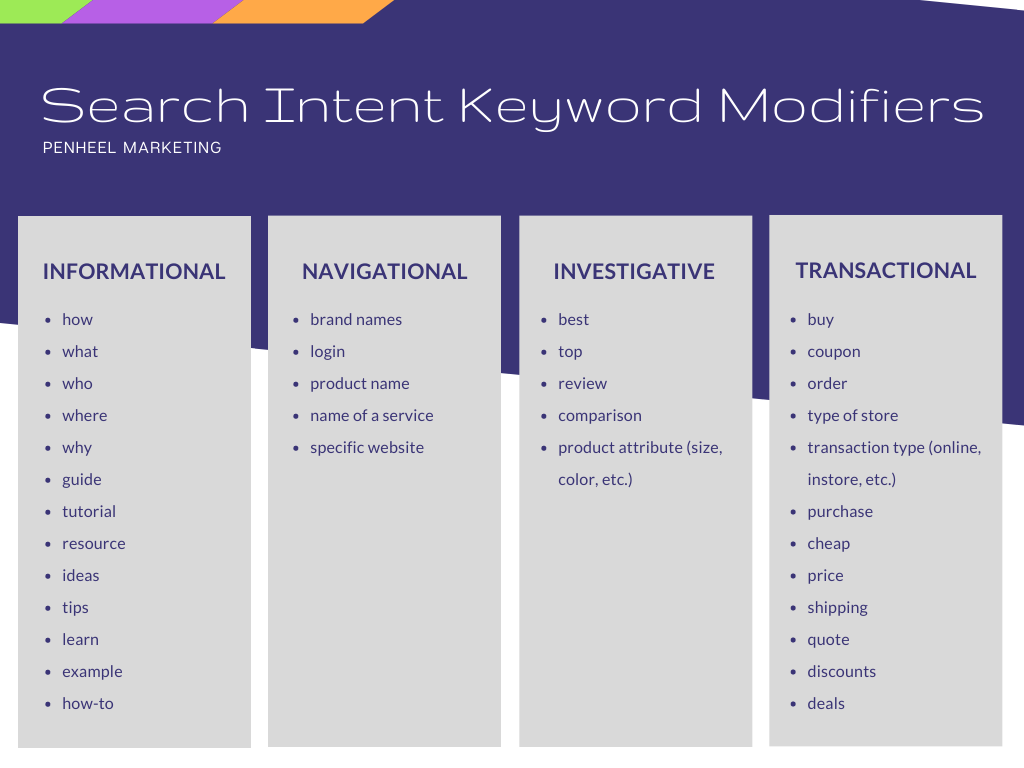Hey Siri, “Who’s the best, small-business accountant in my area?”
Wouldn’t you love your firm to be among Siri’s responses? Sure, you would.
What is search intent?
Search intent is the “why” behind the search reasoning, e.g., to learn, sell, buy, DIY, etc.
It is a descriptive keyword that triggers the search intent. Think of it like those “secret” phrases a magician and assistant know in order to guess something about you. But, they are not as secretive.
4 Search Intent Types
There are four search intent types, including:
- Informational, like “How do I switch to bimonthly payroll?” The seeker is looking for information, and “how” is the informational trigger term.
- Navigational, such as finding a website quicker than typing it in the URL, e.g., “client portal login” entered into the search box. The search results would be the portals you’ve recently logged into.
- Transactional, when users want to buy something, like “Where can I buy QuickBooks?” The transactional trigger term is “buy.”
- Investigative, which is used when making a decision, such as “What is the best small-business accounting software.” The investigative trigger term is best.
Why is it important?
Simple…voice search.
It also aids in better content creation. If you know what people are asking about and why they are asking it, you can create content to align with their intent.
Examples
When an artificial intelligent resource is using your questions to find an answer, there needs to be a way in which it can infer the searcher’s reasoning.
Hey Siri, “What is the weather forecast in [city]?” That’s an informational inquiry because of the word “what.”
Alexa, “Where’s the best place to buy pizza in NYC?” The algorithm could use either the word “where” or “buy” for its results. In this case, the informational response would provide several pizza locations based on ranking. If it were to use the “buy” term, it would provide results based on price. More than likely, you’d get results for both intents in your results list.
Keyword Modifiers
Below is a chart, which you can also download, of search intent keyword modifiers. The terms you see, and others, are what you’d add to content headlines, description and keyword tags, and also social media posts.
Example
- Content Headline: How to create QuickBooks journal entries.
- Modifier: How
- Description tag: Are you stumped by QuickBooks journal entries? Here are three, easy steps to create journal entries your accountant will love.
- Keyword Tag: how to create QuickBooks journal entries
How to find search intent keywords.
There are many intent keyword tools you can purchase. Each has its pros and cons, including SpyFu, Google or Bing AdWords (Ads), Cognitive SEO’s Content Optimizer & Keyword Tool, Backlink Checker by Ahrefs, and many more.
But, there are a couple of tools you can use consistently, and freely, to help you as well, including:
- Google’s search feature. When entering search terms, scroll to the bottom of the page to find the most-common searches related to your topic. This is best performed in a private or incognito browser window so your results are not influenced by your search history.
- AnswerThePublic.com, which aggregates the top questions people ask about thousands of topics.
- Keyword.io to find relevant keywords on several platforms, including Amazon and YouTube.
- Your own website organic keyword analytics to determine what people search for to find your business.
- If you have Google Search Console connected to your website, you can view the Performance/Queries data for even more search phrases people used to find your content.
Secret Tip
If you are just uploading a graphic online, you can put the search intent term on the image file name and add it to the alt tag.
Example
The Search Intent Keyword Modifiers graphic filename is “what-are-search-intent-keyword-modifiers-chart.png.” The description/alt tag is “What are several examples of search intent keyword modifiers for the top four intent types?”
Using the search intent term in those areas allows the image itself to be found on the image search results page on most search engines. It also links back to the website where I’ve uploaded it.
Key Take Away
With more people using listening devices and advanced search techniques to help them find what they need, the intent is key to your content being found by those who seek it.

